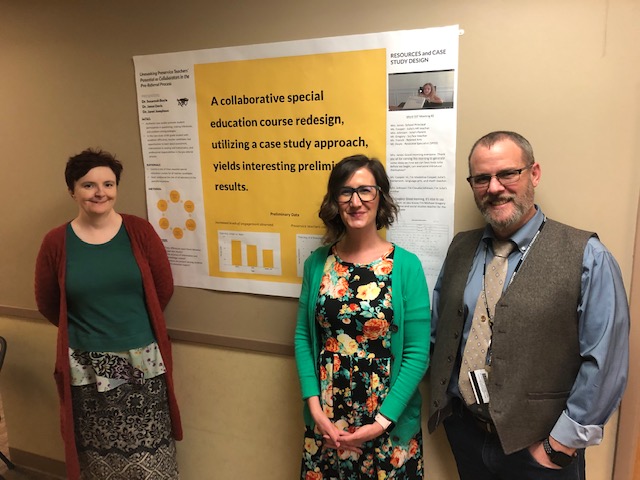February 2020
Drs. Davis, Josephson & Boyle

1. What innovative practice did you incorporate into your classroom?
Working collaboratively, Dr. Jason Davis, Dr. Janet Josephson, and Dr. Susannah Boyle redesigned a core course in the teacher education program to immerse students in a real world simulation. Utilizing a flipped classroom approach, the team was able to move the content delivery on-line freeing the classroom time to focus on real world application. A case study approach was designed with the aid of a child actress to act out and record authentic student responses and behaviors. Consistent with the video recordings, artifacts were developed to teach preservice teachers to analyze student work samples. Throughout the semester, the case study student was used as the common example with a culminating activity requiring participants to create a report describing the students strengths and needs, with supporting data.
2. When did you implement the new practice into your classroom?
The course redesign took place over the summer of 2019 with a first semester launch in the following fall. Since then, modifications were made to enable the course to be fully online.
3. Did the students willingly accept the use of the new practice? What were the reactions of the students?
Students were surveyed to provide feedback on the changes to the course. The case study approach, in combination with the flipped classroom, was highly praised by students. They commented on the clarity of the material as it was presented through the experience of the case study student. They asked for more details and encouraged developing more materials using the case study student so that they could be more deeply emerged in her story.
4. How has the use of the new practice positively affected the classroom learning environment?
When asked to rank the instructional strategies used in this course, the case study was reported as having the greatest support for acquisition of content. The modules used in the flipped classroom approach not only ranked higher than the textbook in this same survey, but students also reported that the material was highly engaging and provided the necessary course content.
5. How has the use of the new practice affected student engagement in the classroom and the level of participation?
The case study approach has demonstrated a greater amount of student engagement in class. While only preliminary self-reported data, students want more case study materials and found the online flipped classroom to be engaging and supportive of their growth.
6. What challenges did you encounter when you were implementing the new practice?
The greatest challenge was in the development. The need to record the case study student, create artifacts, and align them with the course content required the collaborating faculty members to meet regularly during the summer and continue to add content throughout the first semester launch. Additionally, the students needed some support in using the D2L tools and get adjusted to the flipped classroom approach.
7. How did attending Camp IDEA or a CAE Professional Development session contribute to your learning and use of the innovative practice?
Camp IDEA was invaluable to this project. To create both the video and artifact components of the case study required the use of MU Video and D2L’s ability to seamlessly integrate all the moving parts. In addition, the flipped classroom requires students access and engage in the content prior to coming to class. The tricks learned at camp idea, such as setting release conditions and using quizzes to hold students accountable, were vital to ensure the students were accessing the information and prepared to participate in class.